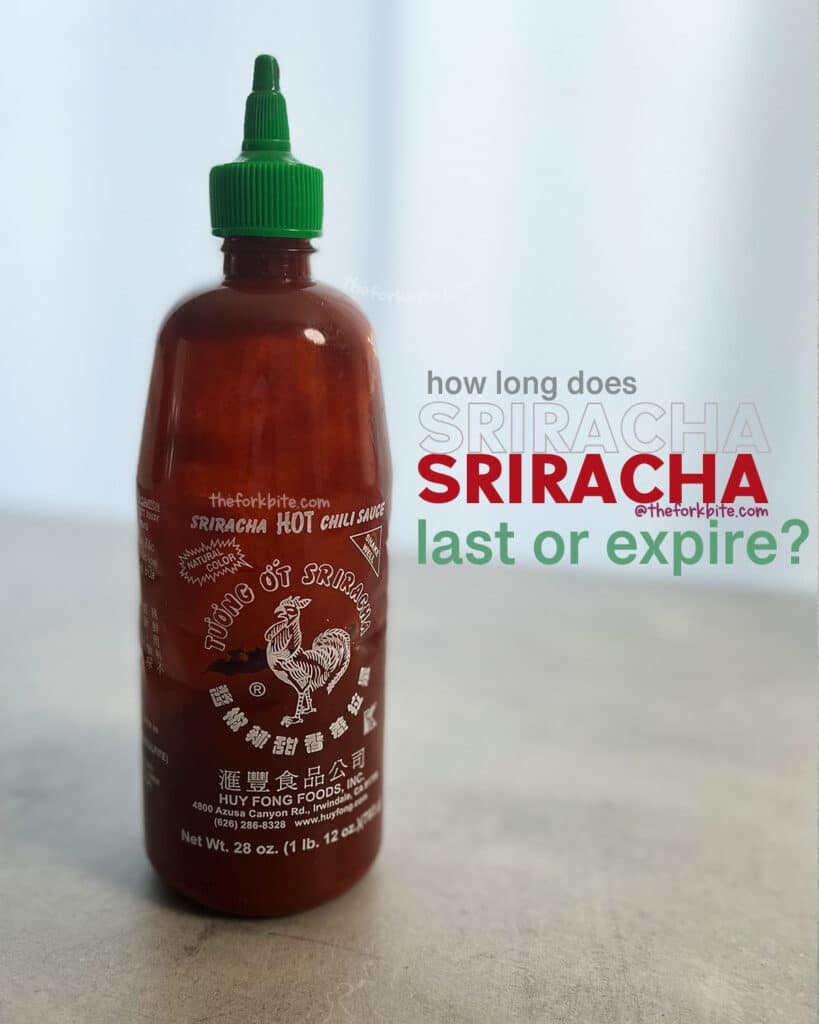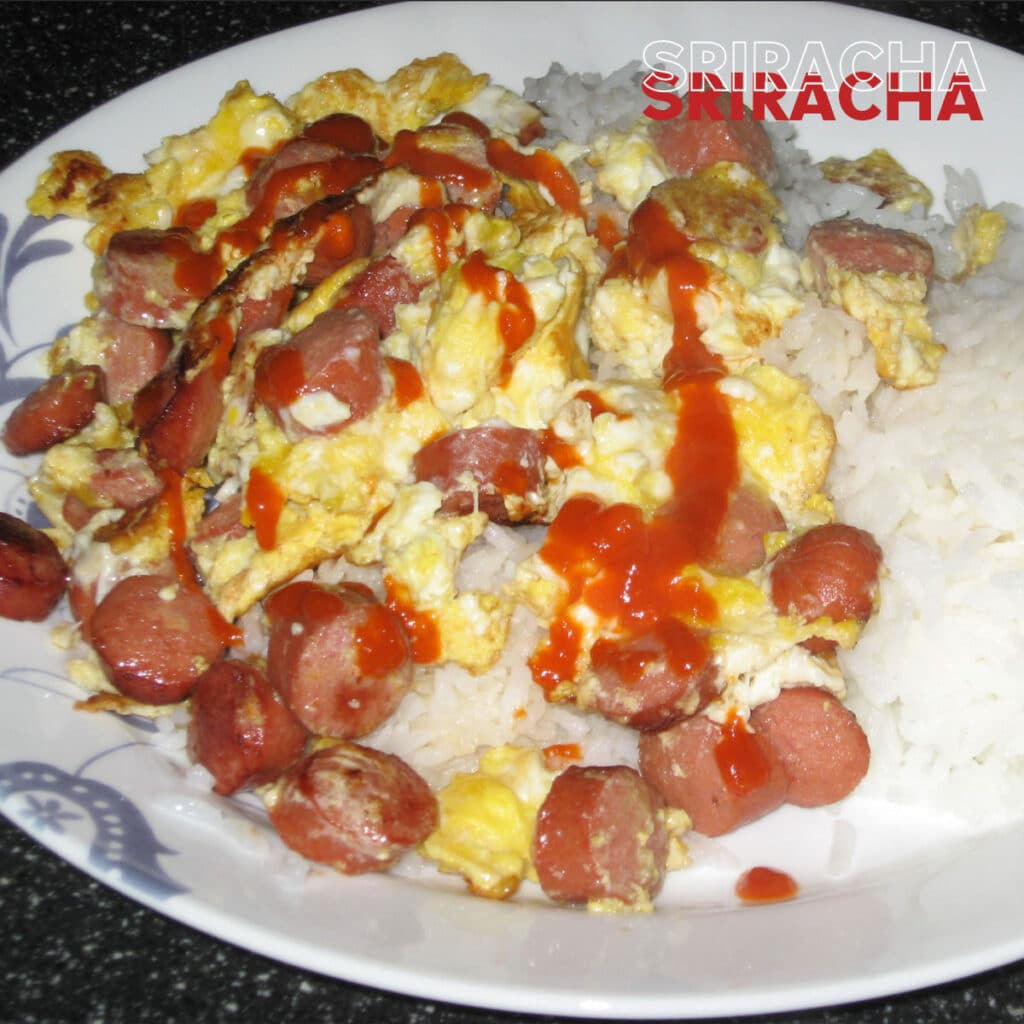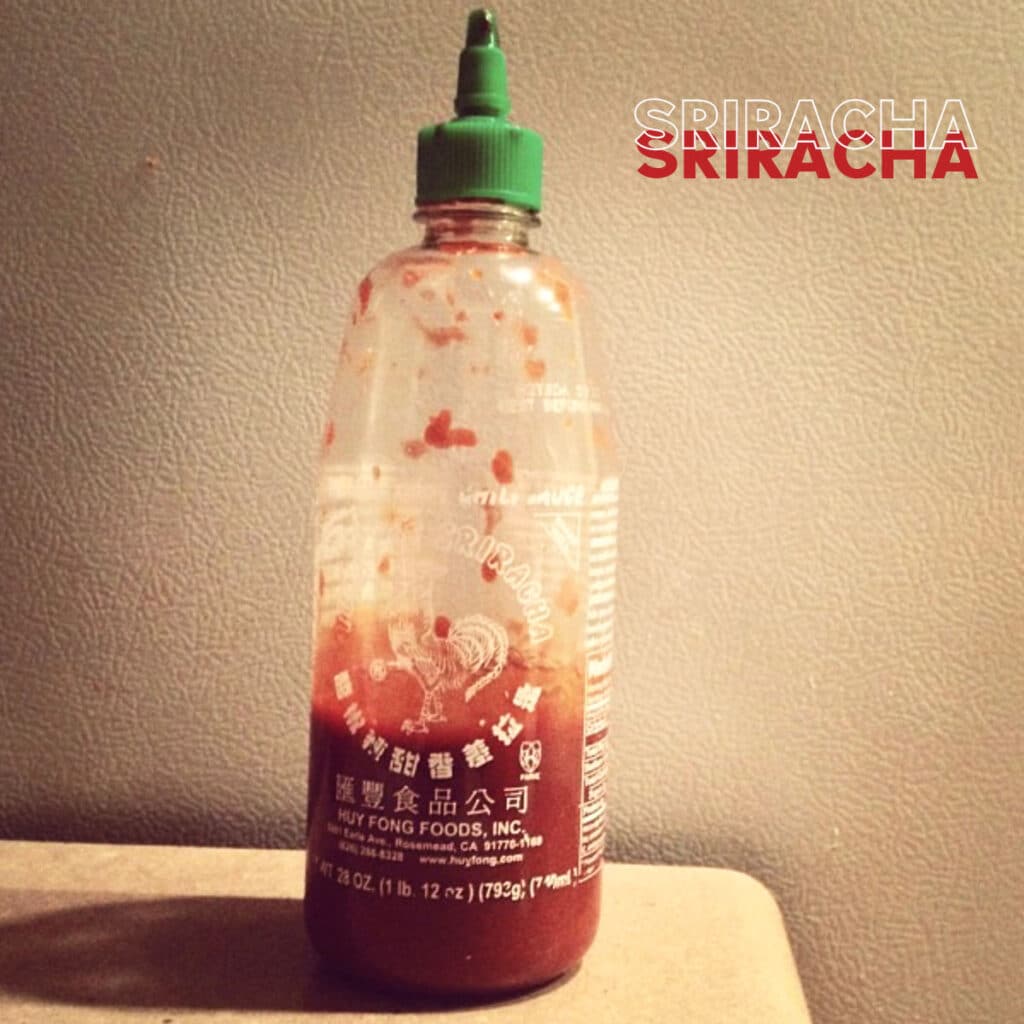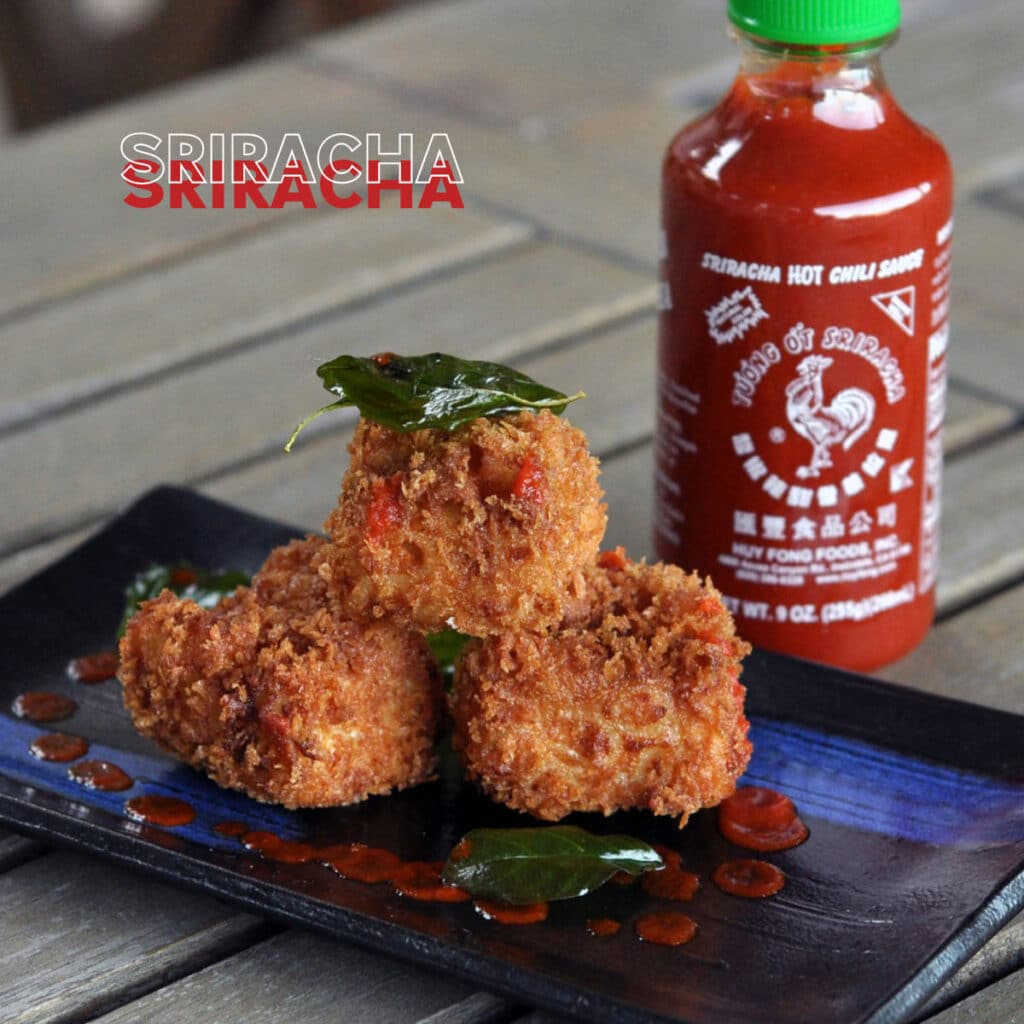Perhaps you've been enjoying the taste of Sriracha after buying the sauce for the first time. But once you have it, you must be curious what's the best way of storing it once you open the bottle. Can Sriracha go bad? Does it need to be refrigerated?
We will discuss all that and some other interesting points about this famous sauce if you care to read on or you can click the "Jump To" section for quick browsing.

If you are a lover of spicy foods like me, you will adore sriracha sauce. When you first pour some out, it looks slightly like tomato ketchup both in color and texture, but boy is it different.
It would be best if you were a spicy food enthusiast to appreciate this hot sauce fully. But once you've tried it, you'll probably be hooked for life.
Some people refer to sriracha sauce as "rooster sauce" because of the rooster depicted on the label. However, it's somewhat misleading because the rooster branded label is the Huy Fong Food Company logo.
Huy Yong Foods sells other sauces and pastes such as Sambal Oelek Chili Paste and Huy Fong Chili Garlic Sauce. The bottles or jars all bear the famous rooster logo, and the sauces inside are all red, so choose with care.
What is Sriracha?
You can describe Sriracha as the ubiquitous squeeze bottle with a green cap and bright red hot sauce affiliated with Thai and Vietnamese gastronomy. It is a renowned culinary staple in many regions around the globe.
It's a strange-looking word, so you might be concerned about how to enunciate it. So as a guide, it is pronounced in three separate syllables: "see-rah- chah."
Its main ingredients are red chili peppers with the addition of vinegar, salt, garlic, and sugar. To enhance flavors and piquancy, you can squirt it into soup or chicken wings.

Due to its popularity, many other brands have emerged and are now available in the market today. The most common brands of this sauce include:
- Huy Fong ("rooster sauce")
- Lee Kum Kee
- Sriraja Panich
- Sky Valley
- Kim Tu Thap
The origin of Sriracha
The company that makes this legendary sauce is Huy Fong Foods—founded by David Tran, who arrived in America in 1978 aboard a freighter called the Huy Fong. Now you know from where his company name comes.
The actual sauce itself was created by a Thai housewife called Thanom Chakkapak, residing in a place in Thailand called Si Racha - hence the name of the sauce - and came up with her creation in the 1930s.
She used red chili peppers, garlic, salt, vinegar, and sugar. Originally named Sriraja Panich, it wasn't long before this in Thailand, inspiring many other taste-a-likes that spawned throughout Southeast Asia.
It was 1980 before it finally came ashore in America, thanks to David Tran's desire to make and sell a hot sauce that reminded him of his home back in Vietnam.
In an interesting anecdote about the history of sriracha sauce, the neighbors who lived close to the Huy Fong Foods factory in Irwindale, California, instigated legal action since they were getting headaches and their throats were getting irritated. Their eyes were burning, all of which they assumed was connected to the hot sauce manufacturer.
In response, David Tran organized free tours of his factory to prove there was nothing toxic about the products he was making. However, he did install some new air control mechanisms, and subsequently, it has receded into the background.
Interestingly there is a 30-minute documentary by Griffin Hammond entitled simple "Sriracha." If you'd like to watch it, please click here.
What does it taste like?
It's typically spicy, with a hint of garlic and an addictive tangy sweetness that will have you clamoring for more. As I mentioned earlier, it looks rather like tomato ketchup on the first appearance, but on first taste, it knocks it out of the park – clean out of sight.
If you think the American-made stuff is spicy, wait till you try some original sauce from Asia. Warning – it could bring tears to your eyes. Tears of both joy and pain – but that sweet pain!

Can Sriracha go bad?
In essence, yes. Any foodstuff will go bad over time, but in the case of this fantastic sauce, it will generally stay at its best for 6 months at room temperature. Regardless, hot sauce continually kept in the fridge will typically stay at its best quality for 4 to 5 years. But once you're hooked, it's never going to be around anywhere near that length of time - trust me.
Every single bottle of Sriracha is stamped with "best before date" towards the neck of the bottle, even though they won't quickly go rancid or spoil. Its the producer's assessment for the duration of the hot sauce to remain at peak quality.
But as time progresses, the flavor will gradually diminish, and the color will darken, but it's not given that time for most sriracha aficionados. So, in the words of a certain Mark Knopfler, why worry?
Simply ditch your Sriracha if you have it dormant in the pantry for 4 to 5 years. Hey! no judgment. It happens all the time; those half-open bottles collect cobwebs in the cupboard or larder.
Does Sriracha need to be refrigerated?
It's a brave bacterium that dares go anywhere near sriracha sauce. Despite the Huy Fong Foods folks saying there is no need to keep it in your fridge. But having said that, like any sauce, hot sauce will fare better and last longer when refrigerated after opening.
If you're anything like me, you'll finish the bottle in one or two months anyway, in which case, you can keep it handy in a kitchen cupboard if you prefer. However, if you presume that the sauce may perch in the cabinet for a year, storing Sriracha in the refrigerator is preferable.

Some of the ingredients of Sriracha – the chili peppers, in particular, have antimicrobial properties and other health benefits. They have been used in various natural medical protocols, including Ancient Chinese medicine and Ayurvedic medicine.
Then there is the distilled vinegar. It too is known for its use in preventing food-borne bacterial growth. All this supports how well sriracha sauce will keep, even though it will inevitably lose a little of its flavor.
Is the pantry truly the right place?
Since it started spreading outside Asia, sriracha sauce has become one of the world's favorite sauces, and it wouldn't surprise me to hear that you have an opened bottle tucked away in your pantry or a kitchen cupboard. But is that the perfect spot to keep it?
The quick answer is no. It doesn't need refrigeration though the ingredients give it long shelf life, even after opening. But in any case, there are a few things you ought to be aware of, and these relate to other spicy sauces.
It's uncommon for hot sauces to spoil.
Two of Sriracha's main ingredients, capsaicin, and vinegar, are the mainstays of this sauce's ability to kill off bacteria. Capsaicin is the stuff that gives chilis their heat, while vinegar is an acid. When combined, they are a formidable barrier to bacterial growth.
Another Sriracha ingredient that has antimicrobial properties is garlic. There are very few others. So, with such a high proportion of antimicrobial-bacterial elements, it's no wonder it has such a long shelf life.
Many other hot sauces have additional ingredients, such as fruits and mustard; the more components, the greater the risk of degradation, especially when you don't store these sauces in the fridge.
So, what are the ingredients in Sriracha?
In addition to the laundry list of ingredients already mentioned (red chilis, garlic, salt, sugar, and vinegar), sriracha sauce also contains the preservatives Potassium Sorbate and Sodium Bisulphite, plus Xanthan Gum – a thickening agent.
Sriracha Sauce will keep its finite list of ingredients for many months – years even when stored after opening in a cupboard. Refrigerate it if you wish, but there is no real need. You can find the full breakdown of ingredients here.
Why does Sriracha turn brown over time?
Initially, most hot sauces are red, thanks to the red chilis, but they do begin to darken after a while, becoming browner. A similar impact is noticeable in most hot sauces like Tabasco.
Notice the same effect in most hot sauces like the Cajun-inspired Tabasco sauce. It's nothing to worry about, though. It's part of the aging process. As Sriracha leans to get thicker with age, it doesn't mean they're going off; chili peppers will continually darken after a while, but it's still palatable. It's just the way of things.
Although you might detect a slight diminishing in flavor after a few months, the heat of the chili intensifies.
Storing your sauce in the fridge will retard any change, although, in my house, it's long emptied before any color change takes place, so I don't bother to refrigerate it.
How long does Sriracha last?
The shelf life printed on the label of a bottle of sriracha sauce gives it a life of at least two years, but that's just the makers erring on the safe side. It will remain perfectly edible well past the published date. Once opened, it will keep well for around six months at room temperature and 12 months or longer if refrigerated.
Having opened a bottle when it is already past its "best by" date, it won't stay good for as long as it would if it wasn't past the date when opened, but it will nonetheless be safe to use well after the printed date.
When you decide to ditch it, like any hot sauce (including tabasco), it will most likely be because the quality has degraded, not because it's turned and is unsafe to consume.

Signs of deterioration of quality in Sriracha
Needless to say that any hot sauce, particularly Sriracha, will gradually deteriorate its quality because of age and inadequate storage conditions.
While neither of these factors signifies that your Sriracha is inedible or stale, they imply that your bottle of hot sauce is not quite as good as purchased. For that reason, meeting expectations is in vain.
If you notice one of the setbacks described below, it's an indication that you're approaching grabbing a new bottle of Sriracha.
1 Discoloration
Obviously, the gradual discoloration of chili pepper that makes up the sauce's body will be evident as time goes by. Your trusty bottle of rooster sauce will be gone from being a vibrant, cherry-red sauce to a deeper muted reddish-brown shade.
2 Shift in flavor
On top of the discoloration or color changes, the hot sauce will likely encounter a slight flavor change in due course. In most cases, you would presume that most hot sauces endure the loss of piquancy as they age. But strange as it seems, Sriracha will even taste "Picante" or pungent as time progresses.
3 Crust over the tip of the nozzle
Occasional incrustation is inevitable over the tip of the nozzle for every bottle of Sriracha after each use. This coating of dry sauce around the edges indicates old sauce. Besides being unpleasant to eat, this texture signifies that the sauce has gone bad.
How to Tell if Sriracha Is Bad?
Although you can keep a bottle of sriracha sauce well beyond its published "best-by" date, it will eventually go off. The signs to look for include:
- The appearance of mold or other organic growth hardly ever happens. But if you come across a bottle that you hid away at the back of a cupboard for years, and it has grown moldy – dispose of it.
- Sriracha sauce gives off a lovely savory, spicy aroma. If you smell it and it smells sour or fermented, throw it out.
- If you notice that your Sriracha has separated, bin it if it's too thick to pour.
- Finally, do a little taste test if it doesn't taste as good as it should, bye-bye bottle.
What is Sriracha used for?
What I love about Sriracha is its versatility not only as a condiment but as to add flavor that pairs well with different types of food. Its zesty and pungent taste is perfect for dipping or marinating just almost everything you fancy reaping benefits from moderate heat.
You'd be surprised just how versatile sriracha sauce is. Take a look at the suggestions below:
1 Use it as a condiment.
When Thai housewife Thanom Chakkapak first concocted her sriracha sauce, she used it as a dip. Whether you go for a presentation by serving it in a small side bowl or simply having a bottle on the table for people to squeeze as much as they like, it tastes just as good.
2 You can add it to sauces.
If you want to add a spicy note to a sauce you make, Sriracha is ideal. It works brilliantly with creamy consistency foods like cream cheese, mayonnaise, and sour cream. It gives any sauce a fantastic tangy kick of spice.
3 Why not stir it through soups?
You can do what Asian folk do and add it to various soups, including chicken noodles, pho, and ramen. It's also great when stirred into soups with a creamy base – Thai soups based on coconut milk and clam chowder.
4 You can use it with meat.
Sriracha is a spicy, tasty condiment that works well with meat or poultry, especially the savory kind. You can also use it to enliven barbecue marinades, and it makes an excellent glaze for chicken legs, thighs and wings, and ham joints.
You can also add it to minced meat and make super tasty burgers or meatloaf. Pulled pork sandwiches with a dollop of Sriracha are divine too.
5 You can use it with eggs and dairy.
I already mentioned how well Sriracha compliments creamy foods, but it's also terrific with dairy products and eggs – especially the yokes. Anything with cheese – well, almost anything – I wouldn't recommend it with cheesecake – but things like a nacho cheese sauce or a bowl of mac and cheese are perfect partners for this spicy sauce.
6 You can use it for drinks.
If you think tomato juice or a Bloody Mary is nice with a dash of Worcestershire sauce, wait till you try them with a teaspoon of sriracha sauce – way to go.




